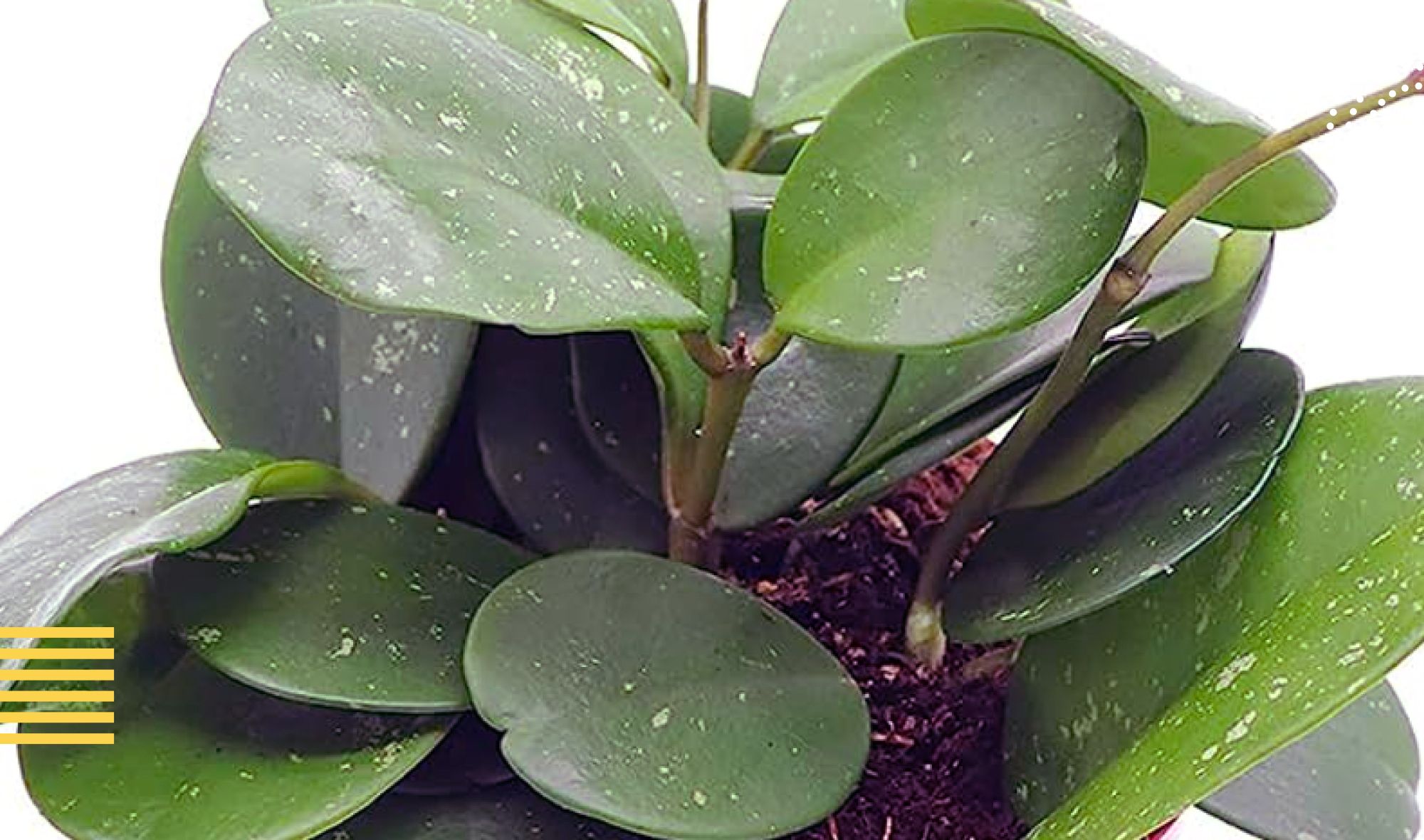Key Takeaways
- Hoya Obovata is a unique houseplant known for its round, deep green leaves with the 'splash' variety featuring speckled white patterns.
- It requires bright, dappled light, a well-draining potting mixture, and controlled watering.
- Fertilization, specifically using nitrogen-rich and phosphorus-rich fertilizers, encourages healthy growth and spectacular blooms.
- Propagation from plant cuttings can be a straightforward process with the right techniques.
- Regular potting and repotting, along with vigilant pest management, are essential for keeping Hoya Obovata healthy and thriving.

Introduction: Embrace the Hoya Obovata Plant
Houseplants have been the beloved cornerstones of many homes for centuries, adding life, color, and a touch of nature to our interior environments. Amidst the vast sea of houseplants, the Hoya Obovata, also known as the Wax plant, has emerged as a unique variety that has captured the hearts of many. Characterized by its deep green leaves, and distinctive for its hardiness, ease of care, and gorgeous blooms, this semi-succulent plant is a truly charming addition to any home.
In this comprehensive guide, we'll navigate the world of Hoya Obovata, learning how to grow and nurture this delightful houseplant. We'll delve into everything from the right light conditions, to the appropriate soil mixture, its watering needs, and even tips on propagation. By the end, you'll be well-equipped to welcome this lovely foliage plant into your home and enjoy the process of caring for it.
Let's embark on this botanical journey, and in the process, discover the joys of bringing nature indoors. For a sneak peek of what awaits, take a look at our range of articles on houseplant care on our blog.
Join our newsletter
Stay on top of the latest in landscaping and lawn care with one valuable tip right in your inbox every Saturday morning.
Identifying Hoya Obovata
The Hoya Obovata, a popular houseplant in the Hoya family, is an enticingly unique variety with features that distinguish it from other trailing plants. Native to Southeast Asia, this fascinating semi-succulent plant is truly a testament to the diversity and beauty of nature.
Known commonly as the Wax Plant due to the waxy appearance of its blooms, the Hoya Obovata is most recognized for its striking deep green leaves. These large, round, and thick leaves are typically marked with silver or white flecks, giving the plant an enchanting appeal. An interesting twist in the Hoya Obovata family is the 'Splash' variety, which possesses an even higher density of these silver splashes, creating a variegated effect that's incredibly pleasing to the eye.
With their captivating foliage and simplicity of care, Hoyas, particularly the Hoya Obovata, have surged in popularity amongst indoor plant enthusiasts, offering an unparalleled allure amidst the world of houseplants.
The Basic Needs of Hoya Obovata

Caring for any plant begins with understanding its essential needs - light, soil, water, and temperature. Let's unravel the specific requirements of the Hoya Obovata.
Light
Hoya Obovata thrives in bright, indirect light. A south-facing window that receives dappled light is an ideal location. Direct, harsh sunlight can scorch the deep green leaves, so be sure to shield your plant from intense rays.
Soil
When it comes to soil, Hoyas prefer a well-draining mixture that closely mimics their natural epiphytic conditions. A mixture of orchid bark, perlite, and peat moss usually does the trick. Soil pH should be slightly acidic to neutral (between 6.1 and 7.5). To get a better grasp on soil types, take a look at our comprehensive guide on fill dirt vs. topsoil.
Join our newsletter
Stay ahead of the curve in all things outdoor.
Get the inside scoop on the latest landscaping, lawn care, and fencing trends with 1 actionable tip every Saturday morning.
Water
Watering is crucial in Hoya Obovata care. While this semi-succulent plant is tolerant of neglect, it's important not to overwater it. A good rule of thumb is to wait until the top inch of the soil is dry before watering thoroughly.
Temperature
Hoya Obovata favors warm conditions. A temperature range of 60°F - 85°F (15°C - 29°C) is suitable for healthy growth.
Understanding these core needs is the first step to successfully grow your Hoya Obovata. As you delve deeper into plant care, remember, every plant is unique, requiring attention, patience, and love.
Fertilizing and Encouraging Growth

Like all living beings, Hoya Obovata needs nutrients to flourish. Fertilization plays a crucial role in promoting vibrant and healthy foliage, as well as encouraging the plant's unique, fragrant blooms.
For a thriving Hoya Obovata, a balanced, water-soluble fertilizer rich in nitrogen and phosphorus is ideal. Nitrogen boosts leaf growth, while phosphorus promotes healthy root development and contributes to the breathtaking flower display. Fertilizing once a month during the growing season (spring and summer) and reducing it to once every other month in fall and winter should keep your Hoya happy.
An exciting aspect of Hoya Obovata care is anticipating its bloom. Usually, with enough light and proper care, mature Hoyas may surprise you with clusters of star-shaped, waxy flowers. The mesmerizing spectacle is definitely worth the wait, often leaving plant enthusiasts in awe of the beauty this houseplant offers.
Propagating Hoya Obovata

Perhaps one of the most fulfilling experiences as a plant parent is successfully propagating a plant, creating a new generation from the existing one. Hoya Obovata, with its robust and forgiving nature, is excellent for beginners to practice their propagating skills. Here's a step-by-step guide:
- Choose a healthy vine and cut a segment with at least one to two nodes. Nodes are the tiny bumps on the stem where new roots or shoots emerge.
- Allow the cut to dry and callous over for a few hours to a day.
- Place the cutting in a well-draining potting mixture, ensuring the node is in contact with the soil.
- Keep the soil lightly moist and provide bright, indirect light.
To dive deeper into the world of propagation and gardening, check out our collection of articles on Gardening.
With patience and care, your Hoya Obovata cutting will soon start to root and grow, offering you the delight of a new plant to nurture and enjoy.
Potting and Repotting Hoya Obovata

Hoya Obovata, like many houseplants, thrives in snug pots and does not require frequent repotting. Generally, repotting every two to three years is ample. Signs that your Hoya Obovata is due for repotting include a rootbound plant, noticeable in the form of roots growing out of the drainage holes or circling visibly at the soil surface.
When repotting, choose a pot that is just one size larger than the current one. This prevents the risk of overwatering, a common issue when pots are too large for the root system. A well-draining potting mixture is essential, as Hoyas don't appreciate soggy feet.
Ideal pots for Hoya Obovata are terracotta or ceramic ones with sufficient drainage. To get more insights into potting, repotting, and various aspects of houseplant care, visit our extensive collection of articles on Houseplants.
Managing Common Pests and Diseases

Despite their resilience, Hoya Obovata plants can sometimes fall prey to common pests such as aphids, mealybugs, scale, and spider mites. It's important to keep an eye out for these unwelcome guests. Early signs of infestation can include yellowing leaves, leaf drop, or a sticky residue on the plant or its surroundings.
To prevent pests, maintain good care practices such as proper watering, providing sufficient light, and keeping the plant clean. If an infestation is identified, isolate the plant immediately to prevent spreading. Most pests can be handled with insecticidal soap or a homemade solution of dish soap and water. Regular inspection and prompt action can keep your Hoya Obovata pest-free and healthy.
Frequently Asked Questions About Hoya Obovata

How often should I water my Hoya Obovata?
Watering your Hoya Obovata largely depends on the specific conditions of your environment. As a rule of thumb, wait until the top layer of the soil feels dry to touch before watering again. Avoid overwatering as it can lead to root rot.
What type of light does a Hoya Obovata need?
Hoya Obovata thrives best in bright, dappled light. A south-facing window that offers filtered sunlight throughout the day is an ideal location.
When should I fertilize my Hoya Obovata?
Generally, fertilize your Hoya Obovata during the growing season (spring and summer) using a balanced, diluted houseplant fertilizer. It's best to hold off on fertilizing during the dormant winter months.
How do I propagate Hoya Obovata?
You can propagate Hoya Obovata by taking plant cuttings with at least one pair of leaves and a node. Plant these cuttings in a well-draining potting mixture and maintain a warm, humid environment for successful propagation.
What are the common pests that affect Hoya Obovata?
Common pests include aphids, mealybugs, scale insects, and spider mites. Regularly inspect your Hoya Obovata for signs of these pests and take immediate action if they are spotted.
When is it time to repot my Hoya Obovata?
If your Hoya Obovata has become rootbound (roots are growing out of the drainage holes of the pot), it's time to repot. This usually happens every 2-3 years, but it can vary depending on the growth rate of your plant.
Conclusion: Your Journey with Hoya Obovata
Growing Hoya Obovata is a rewarding journey, weaving together the arts of botany, decoration, and mindfulness. This blog post has taken you through the essentials of Hoya Obovata care, from recognizing its distinctive features to understanding its light, soil, and water needs. We've explored the magic of its fertilization and propagation and shared advice on potting, repotting, and pest management.
Nurturing a Hoya Obovata adds more than just an aesthetic element to your home; it enhances your space with its vibrant energy and lush, deep green foliage. For more insights and guidance, feel free to revisit our site HeyHome, where the joy of houseplant gardening never ends.
Join our newsletter
Stay ahead of the curve in all things outdoor.
Get the inside scoop on the latest landscaping, lawn care, and fencing trends with 1 actionable tip every Saturday morning.